Children’s Hospital Foundation: ‘Send your valentine to a child in the hospital’
- Exhibited by
- Mark Miller
- Added
- June 12, 2012
- Medium of Communication
- Online
- Target Audience
- Individuals
- Type of Charity
- Healthcare
- Country of Origin
- USA
- Date of first appearance
- February, 2011
SOFII’s view
There are so many lessons to be learned from this wonderful appeal by the Children’s Hospital Foundation in Washington, DC, USA.
Never give up on your hunches, instead continue to nurture and refine them. One day those hunches could be proven right. While you’re at it, make life simple for your donors and potential donors so it’s easy for them to give to you. And never forget the power of sharing. The integration of social media was critical to this campaign’s success, but the real power came from peer-to-peer sharing.
2025 UPDATE: Amazingly, 14 years later, this campaign is still running. It is a powerful and persuasive appeal that fundraisers can rely on!
Creator / originator
- Mark Miller, director of philanthropic marketing and communications, Children’s Hospital Foundation
- Margaret Cohen, associate director of E-Philanthropy
- Watershed Company, online fundraising and advocacy
Summary / objectives
The objective of the Valentine’s Day campaign was to create a compelling feel-good vehicle to engage existing prospects and supporters and grow our list. In addition, we wanted to make a personal and emotional impact for children and families who were spending Valentine’s Day in the hospital. Or, to put it simply, we wanted to make Valentine’s Day more fun for children in the hospital and get more people involved in our mission.
Background
In the USA, Valentine’s Day is celebrated in schools in a big way. So in 2009 and 2010 we experimented with fundraising campaigns around it. Most adults have memories of making cards out of construction paper, decorating shoeboxes as ‘mailboxes’ and handing out valentines to classmates. (For those of us who were less crafty, a trip to the grocery store to pick out cards with cheesy jokes also brings a smile of nostalgia.) We invited people to donate US$25 and send a card to a child in the hospital to help make the day more fun.
That didn’t work so well. But we were still convinced that Valentine’s Day created an opportunity to connect with donors and potential donors. Children’s Hospital Foundation has placed a priority on growing its email house file. In the past, we've had limited success and very tepid organic growth. We decided to approach Valentine’s Day as a list-building, rather than fundraising, opportunity.
Special characteristics
The centrepiece of this campaign was a page that featured sample valentines anonymously addressed to kids in the hospital and gave the viewer a quick and easy way to submit a personalised note of their own. The overall strategy was to deliver a powerful story that cultivated current supporters and acquired new members to the list by executing a fairly aggressive multi-channel campaign. The campaign started with an email to our existing list and we strongly encouraged everyone to share it by email, Facebook and Twitter.
Subsequent emails were segmented: people who took action received emails that thanked them for participating and urged them to share by Facebook, Twitter and email (with easy tools we provided). Those who didn’t take action received repeated appeals to send a valentine. Key messages: remember how much fun Valentine’s Day was as a kid? Kids in the hospital this Valentine’s Day won’t be able to celebrate at school with their friends, but we can still give them a special day to remember.
Calls to action:
- Level one: please take a few minutes to send a valentine that will be shared with a child in the hospital.
- Level two: share this with friends. We'd love to shower each of our patients with valentines and that means we need your help asking other people to send their own as well.
- Level three: make a gift to help kids in the hospital.
The integration of social media was critical to this campaign’s success. We used source codes to track new email names that came from people sharing on Facebook and Twitter. Those new names accounted for 78 per cent of our list’s growth. The remainder of the new names came from email share tools, email forwards, blogs and other sources. Our own Facebook and Twitter posts were productive, but the real power of the campaign was peer-to-peer sharing.
Influence / impact
In 2011, the first year we started the campaign, we were thrilled with our results:
- The initial goal was to collect 1,500 valentines. When it was clear that we were going to surpass that, we upped it to 3,000. We ended the campaign with 3,477.
- We added 2,348 names.
- The list grew by 14 per cent.
- We received US$2,166 in donations.
In 2012, we fine tuned the card distribution plan, put better tracking in place and placed an increased emphasis on social media.
- The initial goal was to collect 5,000 valentines. Again, when the campaign took off and we saw we were going to blow that out of the water, we set a new goal of 8,000 cards. We ended the campaign with 8,426 valentines.
- We added 6,570 new names to the list; 70 per cent of those who took action were new list members.
- Highest source for new names was, by far, the Facebook share on the landing page (after a visitor took his or her initial action by sending a valentine). That source alone accounted for over half of the new names.
- We raised US$5,135 (with the donation form a minor, tertiary action for participants); 90 per cent of gifts came from first-time donors.
- Our house file grew by 35 per cent.
Merits
A few key factors that made this campaign successful may be helpful to other organisations.
- Invite people to make a personal, tangible impact. The campaign gave people a way to engage with children in the hospital in a very real way. We think people were more motivated to participate and tell others because of that personal interaction. That’s also why we sent photos to everyone who sent a card to illustrate the impact they made.
- Offer user-friendly share tools. With Watershed’s help, we provided simple Facebook, Twitter and email share tools on the campaign landing page and they were the major drivers of new names.
- Set a deadline to create urgency. February 14 worked as a natural, urgent deadline for this campaign and studies show that this kind of urgency best motivates response.
- Offer an action that corresponds to the real world. Sending Valentine’s Day cards is something that practically everyone in the USA has done, so it didn’t require any explanation. We tried a similar campaign for people to send masks to children during Halloween and it wasn’t nearly as successful.
- List growth leads to more list growth. Our 2011 Valentine’s Day campaign grew our list by 14 percent and our growth rate for the entire year was 25 percent. We think the success of the 2012 campaign was due in large part to the enthusiasm and social media savvy of those new list members.
Other relevant information
A couple of prominent bloggers came across our campaign and really helped the campaign to go viral. We thanked them separately and shared the photos we’d be sending out to all the participants the day before the thank-you email went out to our list. Next year, pre-campaign outreach to bloggers will figure prominently in our strategy.
Follow-up of the project
Everyone who we added to our list through this campaign will receive a welcome email thanking them for sending a valentine and welcoming them to our online community. This email will share some of our most heart-warming stories from our patients and provide ways that people can get further involved. We'll also send them our electronic newsletter. Our communications are already very personal and focused on patient stories and impact, so we probably will not use distinct messaging for these people, but we’ll track them as a group to monitor donor conversion.
Final notes
Aside from the concrete impact listed above, we brought smiles to lots of kids faces when we delivered the cards. They were amazed that people from all over the country – and the world – sent them a special message. One of the foundation's staff members took pictures (with the proper release forms in compliance with healthcare privacy laws) and we shared them with everyone who sent a valentine. We received some wonderful responses:
‘It brought tears to my eyes to see what joy it brought to the children to just receive a valentine card from someone somewhere in the world who loved them unconditionally.’
‘It was wonderful to have been a part of this project and I definitely look forward to being part of spreading joy. Just a small thank you for making us a part of something so beautiful.’
‘Thanks for letting us know they were appreciated. You’ve made my day!’
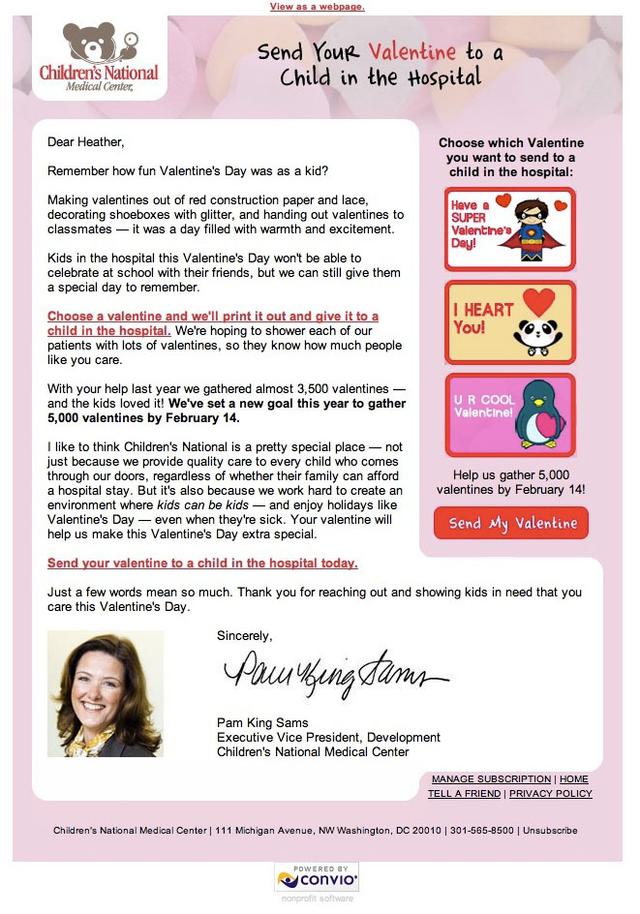 View original image
View original image
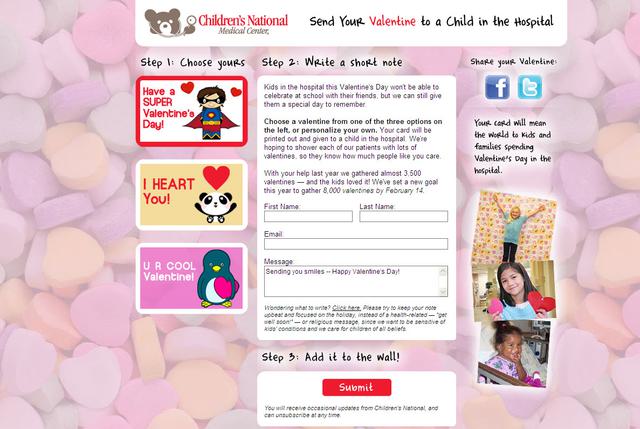 View original image
View original image
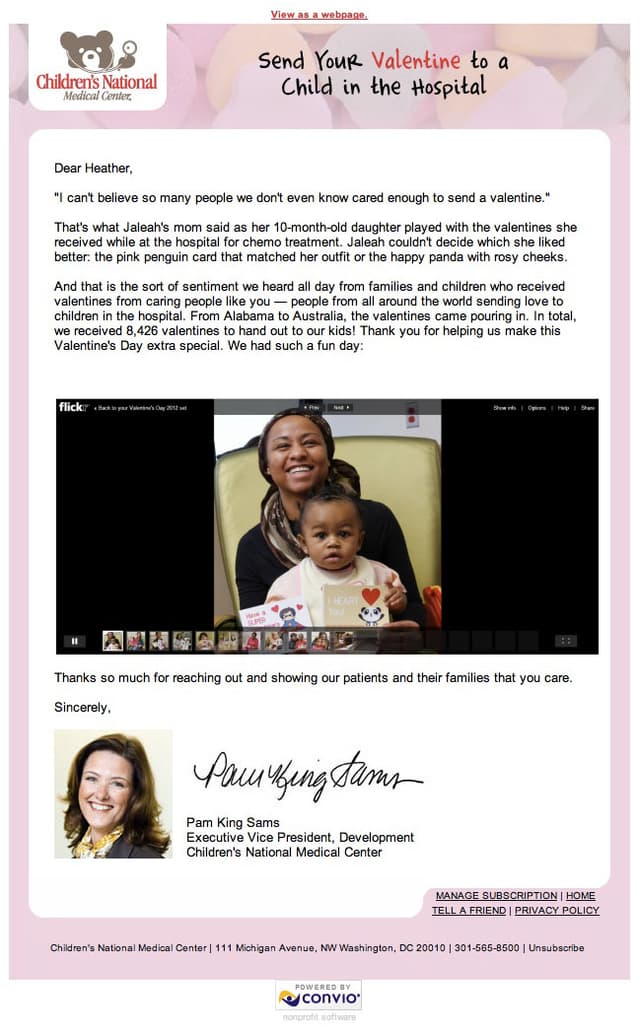 View original image
View original image
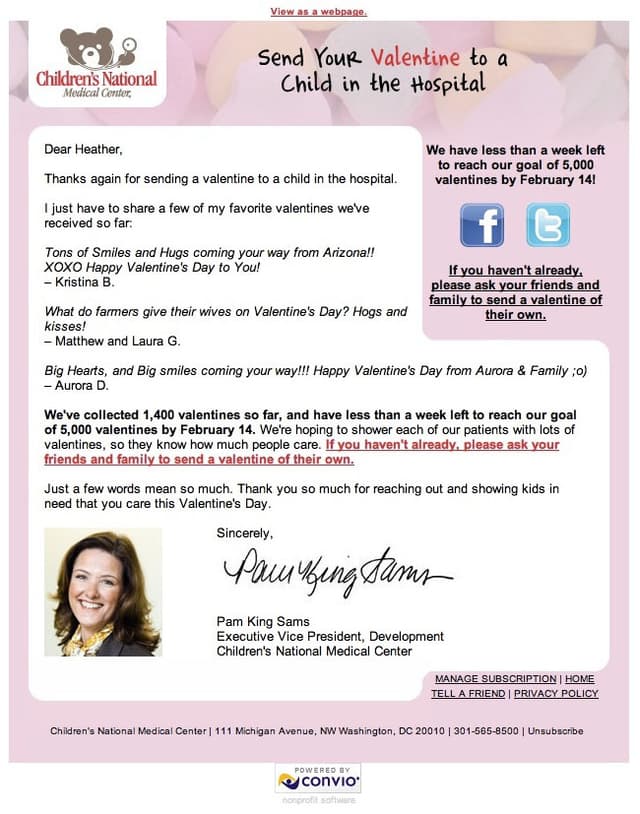 View original image
View original image
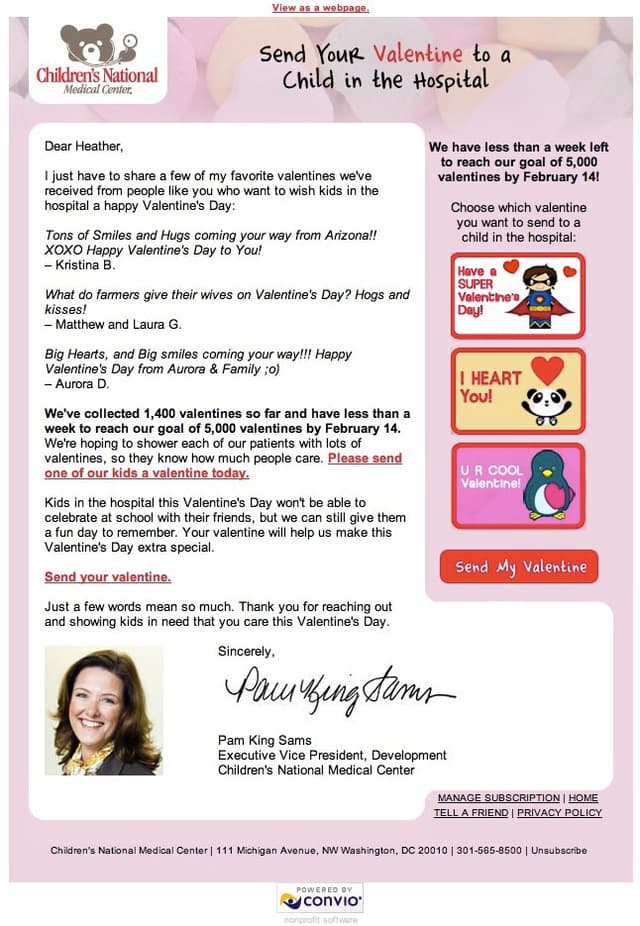 View original image
View original image
Also in Categories
-
- Digital fundraising
- Multi-media
-
















